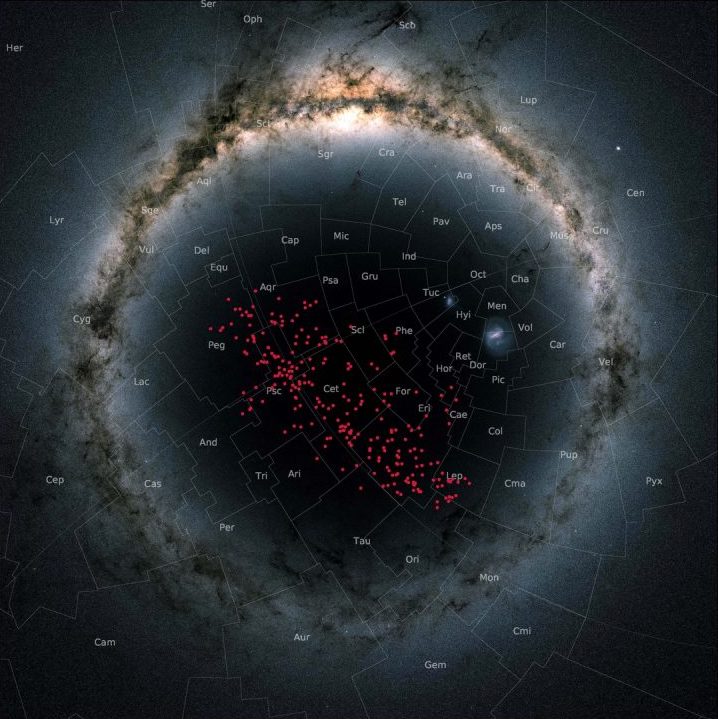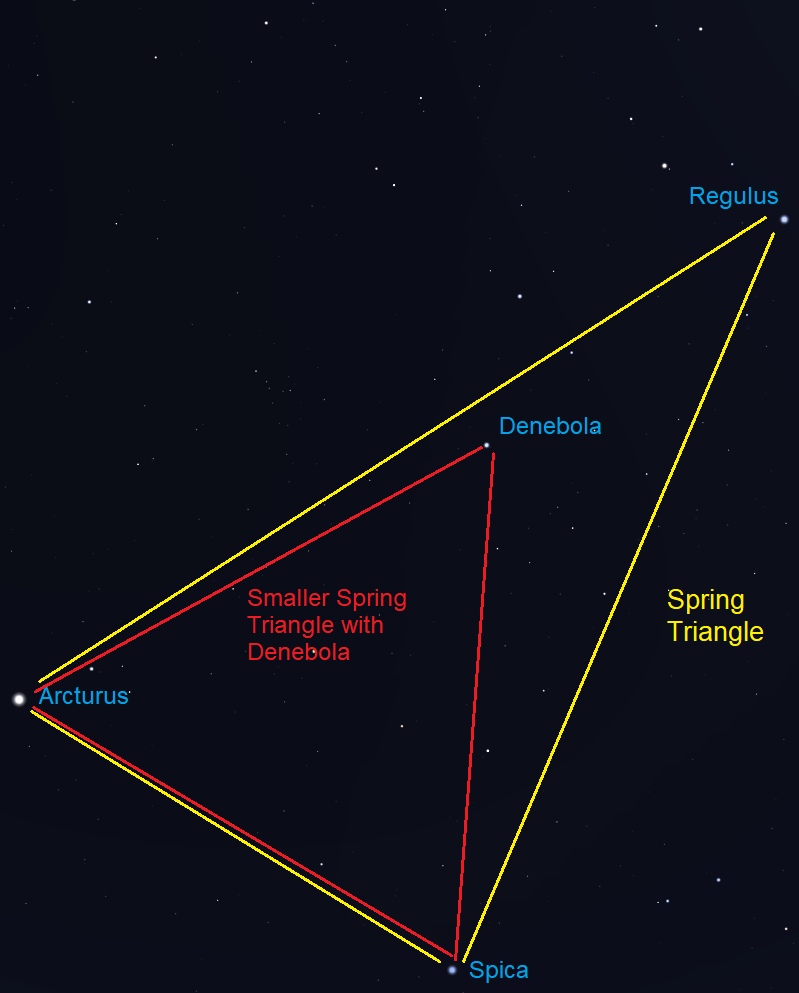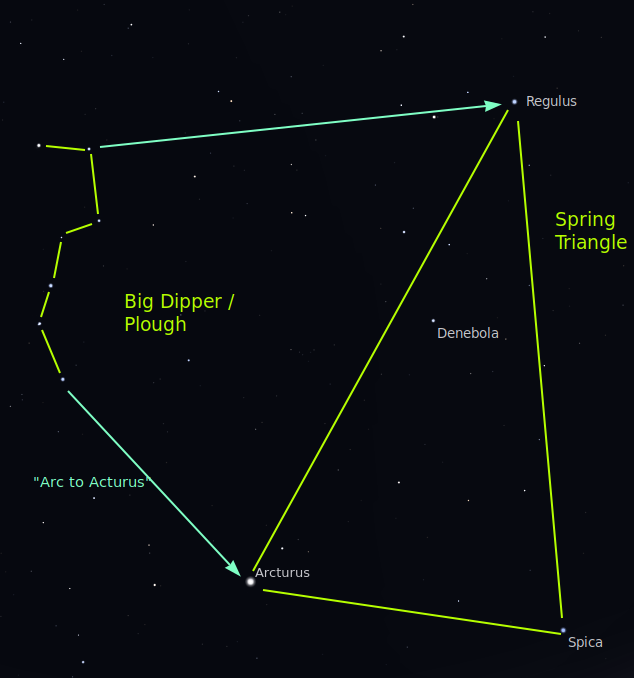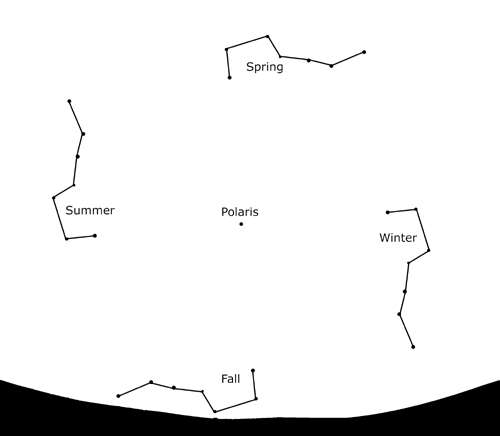
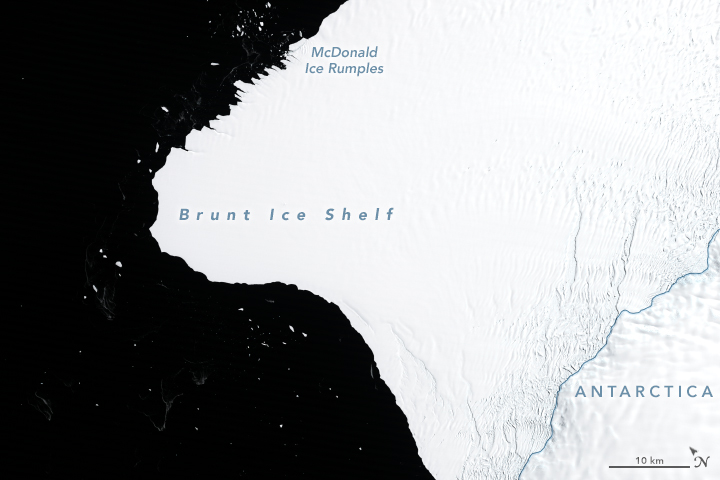
Satellite image of Brunt Ice Shelf taken on January 30, 1986. Image via NASA.
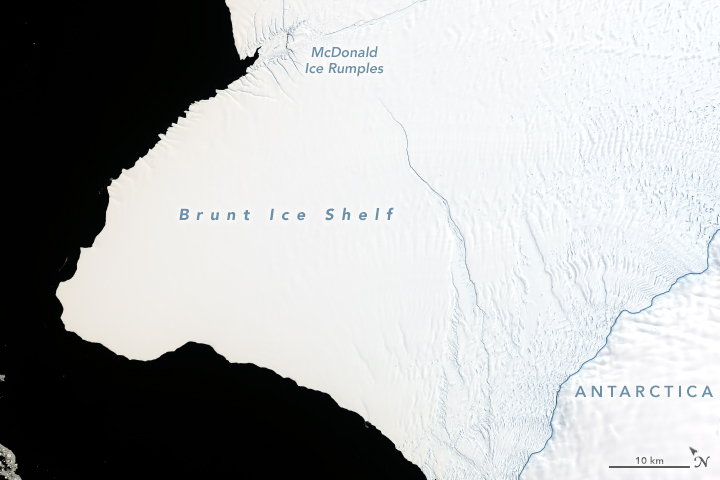
Satellite image of Brunt Ice Shelf taken January 23, 2019. Image via NASA.
Help EarthSky keep going! Please donate what you can to our once-yearly crowd-funding campaign.
Cracks growing across Antarctica’s Brunt Ice Shelf reveal that the shelf is poised to release an iceberg with an area about twice the size of New York City.
No one is sure how how the remaining ice shelf will respond following the break, posing an uncertain future for scientific infrastructure and a human presence on the shelf that was first established in 1955.

January 23, 2019. Image via NASA Earth Observatory.
The crack along the top of the January 23, 2019, image above — the so-called Halloween crack — first appeared in late October 2016 and continues to grow eastward from an area known as the McDonald Ice Rumples. The rumples happen when ice flows over an underwater formation, where the bedrock rises high enough to reach into the underside of the ice shelf. The rocky formation impedes the flow of ice and causes pressure waves, crevasses, and rifts to form at the surface.
The more immediate concern is the rift visible in the center of the image. Previously stable for about 35 years, this crack recently started accelerating northward as fast as 2.5 miles (4 km) per year.
The detailed view shows this northward expanding rift coming within a few kilometers of the McDonald Ice Rumples and the Halloween crack. When it cuts all the way across, the area of ice lost from the shelf will likely be at least 660 square miles (1,700 square km). Although that’s not an enormous iceberg by Antarctic standards, it might be the largest berg to break from the Brunt Ice Shelf since observations began in 1915.

The McDonald Ice Rumples. Image via Primus Stove.
Scientists are watching to see if the loss will trigger the shelf to further change and possibly become unstable or break up. Joe MacGregor is a glaciologist at NASA’s Goddard Space Flight Center. He said in a statement:
The near-term future of Brunt Ice Shelf likely depends on where the existing rifts merge relative to the McDonald Ice Rumples. If they merge upstream (south) of the McDonald Ice Rumples, then it’s possible that the ice shelf will be destabilized.

Location of the Brunt Ice Shelf. Image via NASA Earth Observatory.
The growing cracks have prompted safety concerns for people working on the shelf, particularly researchers at the British Antarctic Survey’s Halley Station. This major base for Earth, atmospheric and space science research typically operates year-round, but has been closed down twice in recent years due to unpredictable changes in the ice. The station has also been rebuilt and relocated over the decades. The detailed image shows the station’s location (Halley IV) until it was closed in 1992. In 2016-2017, the Halley VI station was relocated to a safer location (Halley VIa) upstream of the growing crack.
Calving – the breaking of ice chunks from the edge of a glacier – is a normal part of the life cycle of ice shelves, but the recent changes are unfamiliar in this area. The edge of the Brunt Ice Shelf has evolved slowly since Ernest Shackleton surveyed the Antarctic coast in 1915, but it has been speeding up in the past several years.
Bottom line: Images of growing cracks in the Brunt Ice Shelf in Antarctica show that the glacier is poised to release a huge iceberg.
from EarthSky https://ift.tt/2GIkmf9


Satellite image of Brunt Ice Shelf taken on January 30, 1986. Image via NASA.

Satellite image of Brunt Ice Shelf taken January 23, 2019. Image via NASA.
Help EarthSky keep going! Please donate what you can to our once-yearly crowd-funding campaign.
Cracks growing across Antarctica’s Brunt Ice Shelf reveal that the shelf is poised to release an iceberg with an area about twice the size of New York City.
No one is sure how how the remaining ice shelf will respond following the break, posing an uncertain future for scientific infrastructure and a human presence on the shelf that was first established in 1955.

January 23, 2019. Image via NASA Earth Observatory.
The crack along the top of the January 23, 2019, image above — the so-called Halloween crack — first appeared in late October 2016 and continues to grow eastward from an area known as the McDonald Ice Rumples. The rumples happen when ice flows over an underwater formation, where the bedrock rises high enough to reach into the underside of the ice shelf. The rocky formation impedes the flow of ice and causes pressure waves, crevasses, and rifts to form at the surface.
The more immediate concern is the rift visible in the center of the image. Previously stable for about 35 years, this crack recently started accelerating northward as fast as 2.5 miles (4 km) per year.
The detailed view shows this northward expanding rift coming within a few kilometers of the McDonald Ice Rumples and the Halloween crack. When it cuts all the way across, the area of ice lost from the shelf will likely be at least 660 square miles (1,700 square km). Although that’s not an enormous iceberg by Antarctic standards, it might be the largest berg to break from the Brunt Ice Shelf since observations began in 1915.

The McDonald Ice Rumples. Image via Primus Stove.
Scientists are watching to see if the loss will trigger the shelf to further change and possibly become unstable or break up. Joe MacGregor is a glaciologist at NASA’s Goddard Space Flight Center. He said in a statement:
The near-term future of Brunt Ice Shelf likely depends on where the existing rifts merge relative to the McDonald Ice Rumples. If they merge upstream (south) of the McDonald Ice Rumples, then it’s possible that the ice shelf will be destabilized.

Location of the Brunt Ice Shelf. Image via NASA Earth Observatory.
The growing cracks have prompted safety concerns for people working on the shelf, particularly researchers at the British Antarctic Survey’s Halley Station. This major base for Earth, atmospheric and space science research typically operates year-round, but has been closed down twice in recent years due to unpredictable changes in the ice. The station has also been rebuilt and relocated over the decades. The detailed image shows the station’s location (Halley IV) until it was closed in 1992. In 2016-2017, the Halley VI station was relocated to a safer location (Halley VIa) upstream of the growing crack.
Calving – the breaking of ice chunks from the edge of a glacier – is a normal part of the life cycle of ice shelves, but the recent changes are unfamiliar in this area. The edge of the Brunt Ice Shelf has evolved slowly since Ernest Shackleton surveyed the Antarctic coast in 1915, but it has been speeding up in the past several years.
Bottom line: Images of growing cracks in the Brunt Ice Shelf in Antarctica show that the glacier is poised to release a huge iceberg.
from EarthSky https://ift.tt/2GIkmf9






